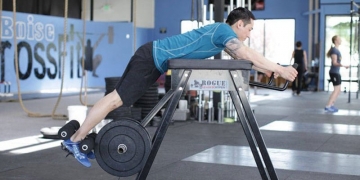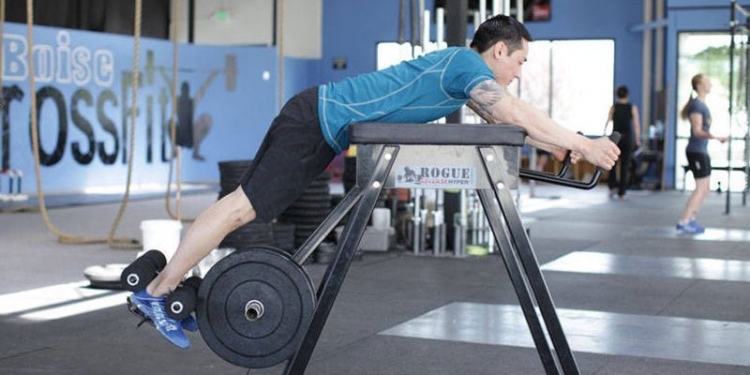Working on the shape and relief of the abdominal muscles is your goal? Then adjustable hyperextension bench or roman chair is will bring benefits.
What’s the bottom line?
The technique of doing this exercise is not complicated:
You need to lie down on the particular training machine with your face down so that the hip joint overhang the front edge of the pillow and the heels are under a different roller.
Best hyperextension bench
The most common exercise for developing back muscles is hyperextension.
The variety of performance options and the exercise versatility allows you to strengthen not only the lower back. But also the muscle that straightens the spine, buttocks and back of the thigh.
In addition to the obvious use of exercise, 45 degree hyperextension bench will be useful in the following situations:
The main load in this exercise is assumed by the extensors of the back (long muscles running along the spine), the gluteus maximus muscles, and also the thigh biceps.
Below we will consider the main types of hyperextension, variations for the home and gym. The classic simulator for hyperextension, a Roman chair, or an ordinary sofa will help us with this.
To get injured with this simulator is very difficult. But the exercise on it forms a muscle corset, strengthens the tendon spine corset and keeps the muscles in good shape.
Hyperextension technique
First of all, you need to figure out when to use hyperextension:
The technique is quite simple:
An easier variant of the exercise is made to work the buttocks. At the bottom, you need to lower so that the body is parallel to the floor.
When performing such a simple exercise, there may still be some faults that need to be approached. Here we will consider the main problems.
In order for the exercise to be beneficial, not harmful, you need to learn its correct technique.
Hyperextension in the gym
The gym is good as it has special equipment that allows you to work your muscles as efficiently and safely as possible. The correct technique for performing hyperextension is the key to the health of your back.
You might be wondering:
Roman chair with hyperextension is a simulator used mainly for developing the lower back. But is also used to train the buttocks, hamstrings, and abs. The simulator is suitable for both training with free weight and weight training.
One of the most popular simulators in gyms in different performance variations and price segment.
The supporting frame of such a device usually has a slightly reinforced profile to give the structure additional stability and safety. The foot support can be adjusted both vertically and horizontally.
When performing an exercise on the press:
It is possible to push the pelvis back a little while landing on the cushion of the simulator. It allows you to relax the pelvic area and maximize the amplitude of movement in the pelvic-spine connection.
During the hyperextension, hammstrings is included in work in isometric contraction, Gluteus Maximus and, of cource, Erector Spinae. Exercise strengthens the lumbar region of the body better than others.
What’s more:
It relieves compression fatigue, increases flexibility and even eliminates non-inflammatory pain in the lower back. Particular attention must be paid to the correct technique for performing this exercise:
It is always necessary to straighten the back above the line of the parallel to the floor, otherwise it will not be called hyperextension.
Sometimes the Roman chair is confused with a 45-degree chair for hyperextension, these are different devices. In the chair for hyperextension, exercises to extend the back are performed in a standing position at a floor angle of 45 degrees with the emphasis on the heels in the limiters.
Roman chair
Exercising on Roman chair is not bad choice if your fitness goal is working on shape and relief of the abdominal muscles. The simulator trains upper abs, develops strength and shape.
It allows you to comfortably and safely train the abdomen and lower back muscles, internal and external thigh muscles.
That’s essential:
The correct position of the pelvis on the bench is very important. Both for the effective work of the abdominal muscles and for the prevention of possible injuries.
We do not recommend using heavy additional weights in the form of parts from the bar:
As the increased amplitude of movement (compared with traditional twists on the floor) turns the exercise into a serious test for the abdomen muscles.
The Roman chair is designed primarily for hyperextension. Where the main movement is flexion in the hip joint, not waist.
In addition, the Roman chair, as a rule, cannot be adjusted to a certain height. So if your height is above average, you may have difficulty with this exercise.
Created for: Athletes of intermediate level and above.
When: On the training day the abdominal muscles before exercise on the lower abdomen. Before twisting in the Roman chair, perform leg lifts in the hanging or reverse twisting. After twisting in the Roman chair, do standard twisting.
How much: 3-4 sets of 10-25 repetitions.
Exercise machines, in particular, a Roman chair, will help to achieve the desired parameters.
Design
The Roman chair refers to the type of power devices. It is designed to perform many exercises aimed at pumping the lower and middle body parts.
The device is made of steel pipes with a rectangular cross section with thick walls. It has the shape of a bench located on a metal frame with foot rollers.
The main purpose:
Pump over the muscles of the abdominal press and oblique muscles of the abdomen. However, the design allows it to work out other parts of the body, depending on the position. In addition to strength training, it is successfully used in fitness and to maintain muscle tone.
It is possible to change the angle of the seat using the bearing assembly. The angle of the backrest can vary from 0 to 30 degrees to the surface. This allows athletes with different levels of training to practice.
Increased structural strength is achieved through the use of radial bends and roundings on the frame. The equipment is safe and can be used both in the room and at home. To improve the effectiveness of classes, additional weight is used, for example, dumbbells.
Advantages of using the simulator
Exercises with the simulator increase the effectiveness of training:
Of course, you can do it by lifting the body from the floor or even through an ordinary bench, catching something on your legs, as you did in childhood. However, the comfort and convenience of a device will make classes more productive.
The benefits of exercising using this device also include:
How to exercise?
The main exercise on this device is lifting the body at an angle to a horizontal surface. The effectiveness of training depends on the correct performance.
In order to do it right, you must:
To achieve the best result, exercises are performed at a slow pace.
Of course, the result of the exercises depends on the correct execution technique.
How to choose best Roman chair?
When choosing a simulator should pay attention to:
Such a simple and reliable equipment, like a Roman chair, will help to achieve high results in the shortest period of time. At the same time, exercises can be combined with listening to your favorite music or even watching movies.
Hyperextensions at home: back & reversed
At home, this exercise can be used to improve your back and stabilize your spine.
Using a fitball
A fitness ball is a great option for working with the press and lower back at home. It is also a good option for pregnant women or people experiencing moderate back pain.
Look how to correctly do hyperextension on a fitball:
Benefits of doing hyperextension outdoors
Pay attention to where you can find two parallel pipes (each pipe is horizontal) of different heights in the nearest sports field. If you found, go there to train the back muscles.
This option is inconvenient as the distance between the pipes cannot be changed, and very often the pipes touch against the hips. From such a point load, girls may bruise. And the weather does not always allow you to go to the yard.
Of course, this is not a special simulator or even a Roman chair, but sometimes it helps.
Performing on the couch
Everything is simple here:
Good and useful entertainment.
One minus – the partner may not be heavy enough, and you outweigh it. So be prepared to put your hands in front of you. With this version of the exercise, the same muscles work as using a chair or simulator.
Using a bench
One of the oldest ways to pump your lower back is to bend over the bench. We need an ordinary DIY hyperextension bench and a Swedish wall. If there is no wall – you can ask a partner to help.
Let’s analyze the option with the wall:
If your partner supports you, show him how to keep you:
It will be convenient if he fixes your feet between the elbow and his body (armpits). The bench is a high equipment, so it’s possible. With a lower tool, it is recommended to put the insurer on a bench.
Hyperextensions at home

Strike a position:
The body is like a straight line so that the edge of the system continues the path of the body with arms crossed in front of the chest. Then we bent forward, making sure that the back is straight and the knees are not bent, then we return to the starting position.
We stay for a few seconds in this position.
When doing this exercise, it is necessary to avoid a strong inverse overextension in the lower back. The number of sets depends on the individual abilities, 3-4 sets with 10-12 reps are often enough, but the number of repetitions can be increased to 4-5 games with 15-20 reps if you want.
This exercise does not replace other activities for the muscles of the back, but it can be a good warm-up for them. For example, deadlift shouldn’t do without hyperextension before it.
You can also do hyperextension at home in a more accessible version, which does not require a training machine. This method is straightforward, it means lifting one hand and the opposite leg at the same time and then lowering to the starting position.
As any exercise, this one has moments that you should pay special attention to:
Try to avoid the mistakes that most beginners make:
Option for the buttocks
To shift the emphasis of the load from the back to the gluteal muscles, the exercise is performed with a rounded back.
It is also worth saying that hyperextension exercise can be performed in the opposite body position (the body is on the support, and the legs are in the air). This is the so-called reverse hyperextension for the buttocks. This option is preferable.
For performance. it will be more convenient to use a Roman chair or a horizontal bench.
The technique is as follows:
Thanks to this version of the exercise, your buttocks will become round and sporty.














Discussion about this post